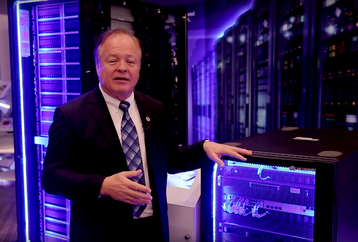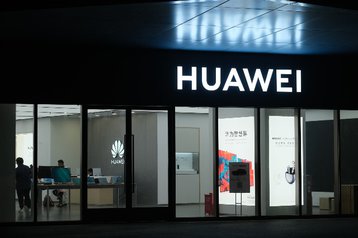The world is switching to a hybrid IT model and Huawei has the ability to furnish the hardware and software at practically every layer of the hybrid infrastructure stack, the company’s straight-talking CTO of data center solutions, Ron Raffensperger, told DCD.
As Huawei launched a product based on Azure Stack at CeBIT 2018, we spoke to Raffensperger about the demand for hybrid IT and the way the company has been prearing itself for a cloud-centric future.
Taking your pick of hybrid
The greatest challenge for enterprises when it comes to cloud deployment is the fact that there is no one-size-fits-all solution, Raffensperger said. “Different customers have different needs; there is no one solution for everybody. While there may be some customers that can go completely to the public cloud, I don’t think there are very many who can [do that].”
He believes that the eventual dominance of the public cloud is inevitable, though he is convinced that enterprises will need private cloud deployments to meet some of their requirements. Indeed, this organizational viewpoint is what makes the focus on the hybrid cloud a core tenet at Huawei.
But what of the periodic announcements – typically made by major public cloud providers - of some enterprises going all-in on cloud? Raffensperger says he doesn’t currently see a need to appeal to this category: “Except for startups, we think there are not that many [enterprises] that are running everything on AWS. The vast majority of traditional IT customers are still evaluating; they haven’t really committed. What we want to do is be able to help them to utilize those services in conjunction with their own internal cloud.”
Integrating the cloud
This is the reason why Huawei had been hard at work, optimizing its ecosystem for hybrid IT. Raffensperger pointed to the launch of the company’s hybrid cloud solution for Azure Stack as one example. First unveiled in a public preview two years ago, Azure Stack was designed to let enterprises extend the public platform’s services and capabilities into their own data centers.
“What we’re trying to do is to leverage our cloud software [for the] hybrid cloud.
”At the same time, Huawei also makes really good servers and storage. That’s why we have partnered with Microsoft on the Azure Stack,” Raffensperger explained. Azure customers that don’t want to use public infrastructure for all of their IT can instead deploy Azure Stack, he says, and integrate it with the Azure public cloud as part of a hybrid deployment.
Raffensperger also pointed to Huawei’s FusionBridge technology that can be leveraged to deploy services across more than one cloud. Commercialized from OpenStack’s cascading proof-of-concept originally created at Huawei, FusionBridge allows for disparate OpenStack deployments to work together as one.
“You have a public cloud that is running on Huawei’s FusionCloud, and you can merge that with AWS or another [FusionCloud-based deployment] – it can be Huawei’s cloud in China, T-Systems’ cloud or the Telefonica cloud. We have plans in the future to be able to do it with Azure and Google,” he said.
The Huawei advantage
Most private cloud deployments force enterprises to work with technology from multiple vendors, Raffensperger noted, citing Huawei’s ability to deliver its private cloud as a single stack of solutions.
Responding to DCD’s question about potential competition from hyperconverged system specialists such as Nutanix and HPE’s SimpliVity, he pointed to how Huawei offers not just hyper-converged infrastructure of its own, but also the requisite flexibility to work with third-party solutions if necessary.
“We just didn’t package different hardware and software to work together. We have the same easy to configure capability. Our [FusionCube] hyperconverged solution can use VMware virtualization, Huawei virtualization, or no virtualization [i.e. bare metal],” he said.
Of course, Raffensperger acknowledged a gap in terms of the services provided by Huawei’s private cloud. This was probably what prompted the company to add more than three dozen compatible cloud services as part of FusionCloud 6.3 that was just announced: “What we’ve found is that customers want more services in the private cloud. What we’ve done [in FusionCloud 6.3] is focus on service.”
The road ahead
A final word of advice from Raffensperger offered a glimpse of where Huawei is heading. Enterprises are having some difficulty moving to the cloud, he observed, and are either held back due to inertia in their organizations, or inherent constrains found in legacy applications.
“It’s easy to take an existing application and run it in a virtual machine. It is much harder to take that application and make it cloud-friendly,” he said, sugesting that one way that enterprises can overcome this is through a process of continuous integration.
Raffensperger added that Huawei is hard at work to make it “a little easier” to integrate new services into the cloud – and to give enterprises a leg up over this challenge.


